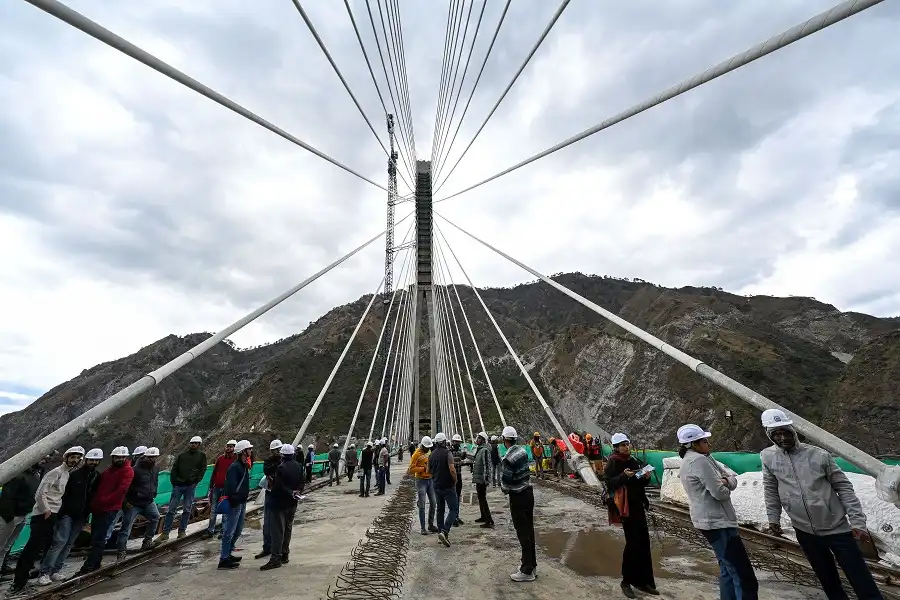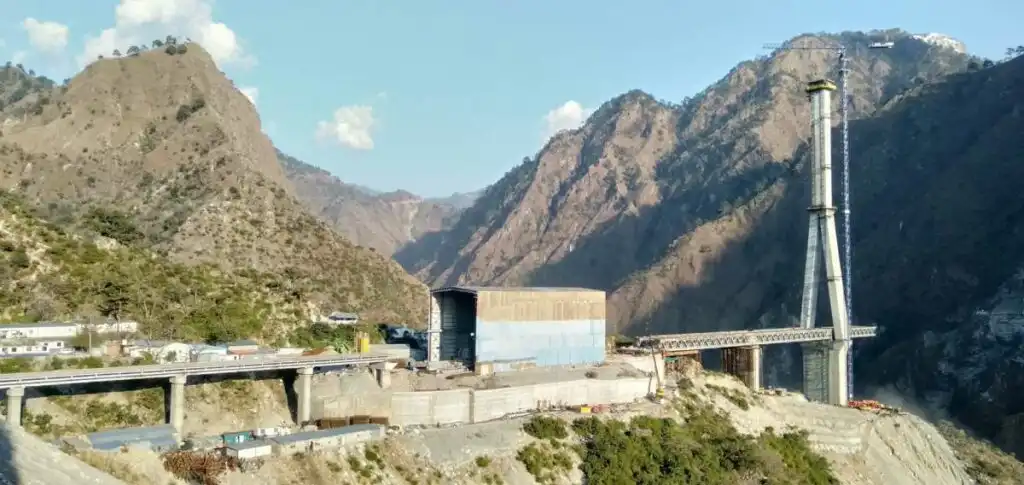India’s first cable-stayed railway bridge, Anji Khad, is being constructed in the Reasi district of Jammu & Kashmir under the Udampur-Srinagar-Baramulla (USBRL) railway project. The Anji Khad bridge is an asymmetrical cable-stayed bridge balanced on the axis of a central pylon. The total deck width is 15 metres and the main span of the bridge is 290 metres. It has been designed to handle heavy storms and wind speed of up to 213 kilometres per hour. Anji Khad bridge will serve as a crucial connector for the passage of a train between Jammu and Kashmir (J&K), is a major chink in the armour of the Indian Railways’ ambitious plan to seamlessly connect Kashmir to the rest of India
Anji Khad Bridge cables installed in record time
The first bridge of its kind, it is made of 96 cables in total and has been fully installed in a record time of 11 months. The total length of the structure is 473.25 metres and its height (from the river bed to the formation) is 196 metres
Earlier, an arch bridge design was proposed for the Anji Khad bridge, similar to the Chenab Bridge arch design. However, it was rejected and a new cable-stayed design was approved. A panel led by an ex-railway board chairman has suggested that the site is not suitable for an arch bridge (concerns over the geological stability of the region). At Anji Khad, Indian Railways, in October 2016, decided to build a cable-stayed bridge.
In a statement, the railway department stated that the design was made using 96 cables — 48 on each central and lateral span. They were installed in a span of 11 months on April 26th. They further added that out of 47 segments 44 are launched. This required support of stay cables. Three remaining segments will be launched later in the next month. Most importantly, the bridge is an engineering marvel which was built under extreme conditions.
Prime Minister Narendra Modi praised the completion of India’s first cable-stayed rail bridge, the Anji Khad Bridge in Jammu and Kashmir. In response to Union Cabinet Minister of Railways, Ashwini Vaishnaw’s tweet informing the completion of the bridge, the PM lauded the project.
The Union Minister informed that the bridge was completed in 11 months and the total length of cable strand used in the bridge is 653 km.

Design of the Anji Khad Bridge
It has been designed to handle heavy storms and wind speed of up to 213 kilometres per hour. The Anji Khad bridge is supported by 96 cables with the cable length varying from 82 metres to 295 metres.
Slopes of the mountain supporting one foundation of the main span have been stabilised by a special hybrid foundation on the Katra end due to space constraints.
The major portion of the bridge works, including the main pylon with a 40-metre-deep hybrid foundation, the central embankment, and the ancillary viaduct, were carried out on the Srinagar end.
The total length of the bridge is 725.5 metres. Considering the ease of construction and typical site conditions, the bridge has been divided into 4 parts: a 120 m long approach viaduct (called an “ancillary viaduct”) on the Reasi side, a 38 m long approach bridge on the Katra end (CA2), the main bridge, crossing the deep valley (473.25 m cable-stayed portion), and the central embankment (94.25 m), located between the main bridge and an approach (ancillary) viaduct.
The main bridge over Anji is a cable-stayed bridge with a total length of 473.25 m and a main span of 290 m. Anji Khad Bridge connects tunnels T2 and T3 on the Katra-Banihal Section of the Udhampur-Srinagar-Baramulla Rail Link project.
This bridge has a single main pylon of 193 metres in height from the top of the foundation, standing at a height of 331 metres above the river bed.
The total length of the bridge is 725 m, consisting of the main bridge with a length of 473.25 metres, an ancillary viaduct of 120 metres in length, an approach bridge of 38 metres on the Katra end, and the central embankment of 94.25 metres in length.
It is an asymmetrical cable-stayed bridge balanced on the axis of a central pylon. The total deck width of the bridge is 15 metres.
The Anji khad Bridge has the support of 96 cables, with cable lengths ranging from 82 m to 295 m. The micropiles of 40-metre depth all around the circumference of the 20-metre hybrid well foundation were used in the main pylon construction.
The bridge shall carry a single railway line plus a 3.75 m-wide service road; there is a 1.5m wide footpath on each side of the deck with an overall width of 15 m.
The Anji Khad Bridge has been designed to handle heavy storms with strong winds. The design wind speed considered is 213 kmph.

Different equipments and techniques used for Anji Khad Bridge Construction
Various unique techniques and equipment are being used, like Jump-Form Shuttering and Pump Concreting Systems, to increase efficiency, provide higher worker safety, and save construction time by about 30 percent.
A state-of-the-art tower crane (imported from Spain) of 40T capacity with an extendable height of up to 205 metres is being used for enhancing construction activities at heights up to 193 m. The Anji Khad Bridge has an integrated monitoring system by means of numerous sensors installed at various locations on the bridge.
The work for Detailed Design and Construction Supervision (DDC) of this iconic bridge has been assigned to the Italian company ITALFERR (a company belonging to the Italian State Railways Group “Ferrovie dello Stato Italiane”), and bridge project management and consultancy was assigned to the company COWI, UK. The design has been based on Indy, started by Photo by Eurocodes, where necessary.
Site-specific earthquake parameter studies were carried out by the Department of Earthquake Engineering, Indian Institute of Technology, Roorkee, to define the seismo-tectonic framework for the region. It is the study of the relationship between the earthquakes, active tectonics and individual faults of a region. It is used to analyse the reasons for seismic activity in an area by analysing a combination of regional tectonics, recent instrumentally recorded events, accounts of historical earthquakes and geomorphological evidence. This information can then be used to quantify the seismic hazard of an area.
Due to the importance of the bridge, a large number of sensors will be placed on it to monitor the structural health of the bridge during service.

Connectivity through Anji Khad Bridge
The bridge connects Katra and Reasi via tunnels T2 and T3 on the Katra-Banihal section. According to Rajesh Khare, Senior PRO of Northern Railway, the Anji bridge forms an important link in Indian Railways’ aim to connect J&K to the rest of India with all-weather rail connectivity.
Trains will be able to run at speeds of 100 kilometres per hour on the bridge. A large number of sensors have been placed on the Anji bridge so that the structural health can be monitored regularly. Also, an explosion with up to 40 kg explosives will also not be able to destroy the bridge, claim railway officials.
The bridge is scheduled to be opened this month.
For updates on bridge opening and other details, watch out this space for more.
Source- NDTV, Times of India, Economic Times, PTI


